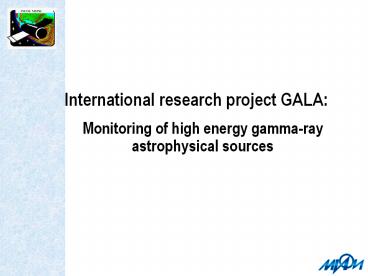International research project GALA: - PowerPoint PPT Presentation
Title:
International research project GALA:
Description:
To realize the continuous monitoring of gamma-ray astrophysical ... Active Galactic Nuclei; search new extragalactic high-energy gamma-ray discrete sources. ... – PowerPoint PPT presentation
Number of Views:19
Avg rating:3.0/5.0
Title: International research project GALA:
1
International research project GALA
- Monitoring of high energy gamma-ray astrophysical
sources
2
Preface
- Several hundreds of point high-energy gamma ray
astrophysical sources were discovered to date,
but more then half of those sources are still not
identified. - Taking in to account that gamma-ray emission is
associated mainly with active variable objects,
the continuous monitoring of celestial sphere
using the telescope with high angle and time
resolutions allow to identify a noticeable part
of known unidentified sources and to discover new
high-energy gamma-ray sources. - To realize the continuous monitoring of
gamma-ray astrophysical sources it is proposed to
develop wide-aperture gamma telescope GALA with
high angle resolution in 10-100 MeV energy range
and install it as additional payload onboard
Meteor-M satellite. Meteor-M is the Russian
meteorological low polar orbit satellite designed
by Russian Space firm VNIIEM.
3
GALA scientific objectives
- The main task of project GALA is continuous,
during several years, monitoring of celestial
sphere aimed for - Clarification the nature of unidentified point
high-energy gamma-ray sources search of new
gamma-transients. - Study of discovered gamma-ray pulsars search the
pulsed gamma-ray emission from unidentified
sources. - Search of high-energy gamma-radiation from
galactic binaries and supernova remnants. - Investigation of known Active Galactic Nuclei
search new extragalactic high-energy gamma-ray
discrete sources. - Study of diffuse high-energy gamma-ray emission.
- The additional scientific goal of GALA project
- Study of cosmic ray isotope fluxes in
20-200 MeV/n energy range in near-Earth space.
4
GALA instrument diagram
Telescope systems 1) Silicon tracker. Purpose ?-
quantum conversion and ee- pair detection.
Structure 16 detecting planes 400?400 mm
each. Distance between planes 20 mm. Each plane
consists of two layers. First layer active
converter SN1-SN16 (Each of these views is the
single-sided, AC-coupled, 500 ?m thick silicon
strip detector with a readout ). Second layer -
double-sided (X, Y), 300 ?m thick silicon
microstrip detector S1-S16 with readout peach 250
?m). 2) Anticoincidence. Purpose Rejection of
cosmic ray charged particles. Structure CU the
upper anticoincidence detector CS1-CS4 side
anticoincidence detectors CD1-CD4, CD down
anticoincidence detectors
5
Trigger
Gamma-ray trigger
, where
Isotope trigger
6
Main physical characteristics
Characteristics EGRET GALA
Energy range 30 MeV - 30 GeV gt10 MeV
Field of view 0.5 sr 3 sr
Angle resolution 15? (30 MeV) 5.5? (100 MeV) 1.2? (1 GeV) 4.9? (30 MeV) 1.6? (100 MeV) 0.3? (1 GeV)
Sensitive area 1500 cm2 200 cm2
Energy resolution 10 30 (10-100 MeV)
Dead time gt100 ms lt1 ms
7
Effective area
8
Field of view
9
Angular resolution
10
Sensitivity to point sources
11
Meteor-M satellite
Main characteristics
GALA
Orbit Circular, sun-synchronous
Altitude 835 km
Inclination 98.68?
Pointing configuration Orbital
Pointing accuracy 0.1?
Positioning Better then 30 m
Accuracy of onboard time synchronization with UT 2 ?s
Satellite mass 800 kg
Payload mass 320 kg
Power 1.4 kW
Telemetry 122 Mbit/s
Satellite lifetime More then 5 years
12
Telescope GALA onboard Meteor-M
GALA technical characteristics
GALA overall dimensions 600?600?600 mm
Instrument mass 100 kg
Power consumption 150 W
Mass memory 2 Gbytes
Required pointing accuracy 0.1?
Required accuracy of onboard time synchronization with UT Better then 10 ?s
13
Comparison between EGRET and GALA exposures
GALA 1 year of observations
EGRET Cycles 1, 2, 3, 4
Units 108 cm2s
14
GALA exposure for point source vs. time
15
Expected results of observations
Number of detected gamma-quanta with energy
gt30 MeV versus spectral index ? of 3EG
sources demonstrated very low time variability
16
Expected results of observations
Expected GALA count maps of Galactic center region
17
GALA collaboration
- Collaborators from Russian side
- Moscow Engineering Physics Institute (State
University) - Sternberg Astronomical Institute (Moscow State
University) - Institute of Astronomy RAS
- Lebedev Physical Institute RAS
- All Russian Scientific and Research Institute of
Electro mechanics (VNIIEM) - Foreign collaborators
- National Institute of Nuclear Physics (INFN),
Italy































